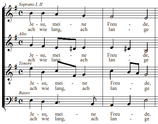| Revision as of 11:28, 31 January 2022 editGerda Arendt (talk | contribs)Autopatrolled, Extended confirmed users, File movers, Pending changes reviewers, Rollbackers383,118 edits try link to illustration← Previous edit | Revision as of 19:55, 31 January 2022 edit undoDying (talk | contribs)Extended confirmed users11,773 edits copyedit as per id 1069046593 and diff 1069129853Next edit → | ||
| Line 1: | Line 1: | ||
| {{Main page image/TFA|image= Jesu, meine Freude (Bach) Anfangstakte.png |caption= The beginning of the first movement}} | {{Main page image/TFA|image= Jesu, meine Freude (Bach) Anfangstakte.png |caption= The beginning of the first movement}} | ||
| ''''']''''' ('Jesus, my joy'<!-- conform with mos:single for simple glosses -->), {{BWV|227}}, is a ] |
''''']''''' ('Jesus, my joy'<!-- conform with mos:single for simple glosses -->), {{BWV|227}}, is a ]. In eleven ]s for up to five voices, it is his longest and most musically complex motet. It is named after the 1653 ] "{{lang|de|]|italic=no}}" by ]; the hymn's six ]s <!-- reworded due to complexity --> form the motet's odd-numbered movements. Bach used the ] by ] in five different ] settings ''(example<!-- reworded as image does not illustrate five different chorale settings --> pictured)''.<!-- split sentence due to length, using wording in diff 1065983810 --> The hymn's text focuses on an emotional bond to ], complementing the doctrinal text from the ] used for the even-numbered movements. ''Jesu, meine Freude'' is one of the few works by Bach for five vocal parts, in ]. It is unclear when the motet was written. Bach scholar ]<!-- added wolff as per diff 1065910430 --> believed that Bach may have compiled it to educate<!-- reworded to conform with character limit --> ] in <!-- removed "both" to conform with character limit --> composition techniques and theology; an earlier theory that it was written for a 1723 funeral in ]<!-- reworded to conform with character limit --> is now discredited. This motet was the first of his to be recorded, in 1927. {{TFAFULL|Jesu, meine Freude, BWV 227}} | ||
| {{TFArecentlist| | {{TFArecentlist| | ||
Revision as of 19:55, 31 January 2022
 The beginning of the first movement
The beginning of the first movement
Jesu, meine Freude ('Jesus, my joy'), BWV 227, is a motet by J. S. Bach. In eleven movements for up to five voices, it is his longest and most musically complex motet. It is named after the 1653 Lutheran hymn "Jesu, meine Freude" by Johann Franck; the hymn's six stanzas form the motet's odd-numbered movements. Bach used the hymn tune by Johann Crüger in five different chorale settings (example pictured). The hymn's text focuses on an emotional bond to Jesus, complementing the doctrinal text from the Epistle to the Romans used for the even-numbered movements. Jesu, meine Freude is one of the few works by Bach for five vocal parts, in a structure of symmetries on different layers. It is unclear when the motet was written. Bach scholar Christoph Wolff believed that Bach may have compiled it to educate his choir in composition techniques and theology; an earlier theory that it was written for a 1723 funeral in Leipzig is now discredited. This motet was the first of his to be recorded, in 1927. (Full article...)
Recently featured: